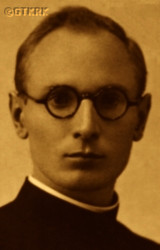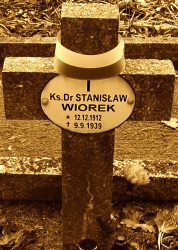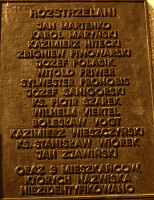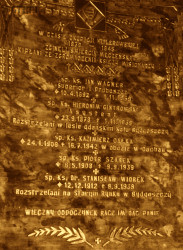Roman Catholic
St Sigismund parish
05-507 Słomczyn
85 Wiślana Str.
Konstancin deanery
Warsaw archdiocese, Poland
full list:
displayClick to display full list

searchClick to search full list by categories
wyświetlKliknij by wyświetlić pełną listę po polsku

szukajKliknij by przeszukać listę wg kategorii po polsku

Martyrology of the clergy — Poland
XX century (1914 – 1989)
personal data
religious status
Servant of God
surname
WIOREK
surname
versions/aliases
WIÓREK
forename(s)
Stanislav (pl. Stanisław)
function
religious cleric
creed
Latin (Roman Catholic) Church RCmore on
en.wikipedia.org
[access: 2014.09.21]
congregation
Congregation of the Mission CMmore on
en.wikipedia.org
[access: 2013.05.19]
(i.e. Vincentians, Lazarists)
diocese / province
Gniezno and Poznań archdiocese (aeque principaliter)more on
www.archpoznan.pl
[access: 2012.11.23]
academic distinctions
Doctor of Theology
date and place
of death
09.09.1939

Bydgoszcztoday: Bydgoszcz city pov., Kuyavia‐Pomerania voiv., Poland
more on
en.wikipedia.org
[access: 2021.06.20]
details of death
During summer of 1939 returned to Poland to help in ministry in Bydgoszcz (possibly was to take a vicar post).
After German invasion of Poland on 01.09.1939 (Russians attacked 17 days later) and start of the World War II, after start of German occupation, apprehended by Germans on the street with Fr Peter Szarek in a street roundup of incidental passers by (Congregation's house in Bydgoszcz Germans plundered and seized earlier, on 05.09.1939).
In retaliation for events of so‐called Germ. „Bromberger Blutsonntag” (Eng. „Bydgoszcz Bloody Sunday”) of 03‐04.09.1939, when Polish troops — after being shot at by German 5th column in Bydgoszcz, after German attempt at sabotage and armed rebellion — bloodily crushed treacherous German effort murdered by the Germans in the public execution of 50 Poles — with Fr Szarek, among others — on the Old Market Square in Bydgoszcz.
The bodies were displayed in the Old Market Square for six hours, as an intimidatory measure to terrorize the town's population.
Falling down during execution was to leave a trace of hand on the Jesuits' church wall (it might have been Fr Szarek's).
Germans smeared the wall with black tar but the trace soon reappeared.
Germans then ordered to smack a hole in the wall, patch it up and plaster over.
Without success — the trace was to reappear again.
Germans therefore put the whole church down.
Bydgoszcz became a place of particular German repressions. After capturing the city on 05.09.1939, the Germans exploited events of the Germ. „Bromberger Blutsonntag” and began bloody repressions against Poles. The Germ. Wehrmacht (Eng. Armed Forces), appointed by the Germ. 4. Armee (Eng. 4th Army), which captured Bydgoszcz, the commander of Bydgoszcz, Major General Walter Braemer, issued on 08.09.1939 an order, to cleanse the city of „criminal Polish elements”. The Germans began searching private homes, apartment by apartment. If weapons, e.g., souvenir sabres, etc., were found, the occupants were shot on the spot. Several public executions were also carried out.
The action was carried out by soldiers of the Germ. Wehrmacht and the genocidal Germ. Einsatzkommando 1/IV (Eng. 1/IV Task Group), part of the Germ. Einsatzgruppen (Eng. Operational Groups), a formation of the Germ. Sicherheitspolizei (Eng. Security Police), i.e. SiPo, and the Germ. Sicherheitsdienst des Reichsführers SS (Eng. Security Service of the Reichsführer SS), i.e. SD, subordinated to the Germ. Reichsicherheitshauptamt (Eng. Reich Main Security Office), i.e. RSHA, operating behind the German 4th Armee.
The repressions then turned into an organized extermination action — as part of the Germ. «Intelligenzaktion» (Eng. Intelligence Action), i.e. the extermination of the Polish intelligentsia and the leadership classes of Pomerania, based on the so‐called Germ. Sonderfahndungsliste (Eng. Special Wanted List), i.e. a proscription list of names of „enemies of the Reich”, prepared before the German aggression, or on some other proscription list, drawn up ad hoc on denunciations from local Germ. Volksdeutsche.
It was carried out by units of the genocidal Germ. Volksdeutscher Selbstschutz (Eng. Ethnic German Self‐Defense), whose members were Germ. Volksdeutsche from Bydgoszcz and the surrounding area, supervised by the paramilitary, genocidal Germ. Die Schutzstaffel der NSDAP (Eng. NSDAP Protection Unit), i.e. «SS», subordinate to the National Socialist German Workers' Party NSDAP, and supported by the Germ. Ordnungspolizei (Eng. Order Police), i.e. OrPo, a formation directly subordinated to the Germ. Chef der Deutschen Polizei (Eng. Chief of the German Police), the genocide master Heinrich Himmler. By the end of 1939, the Germans had murdered c. 5,000 Poles in public and hidden executions — many in nearby forests — including c. 1,500‐1,900 from Bydgoszcz alone.
Arrested Poles, after initial interrogations, were held mainly in the IL Bromberg internment camp, established on the premises of the barracks of the Polish 15th Light Artillery Regiment at 147 Gdańska Street. From there, were transported to the execution site or to concentration camps. In 09.1939 alone, c. 3,500 Poles (approximately 2.5% of Bydgoszcz's Polish residents) passed through the camp.
cause of death
mass murder
perpetrators
Germans
sites and events
Street round‐upClick to display the description, Pacification of Bydgoszcz 05‐12.09.1939Click to display the description, «Intelligenzaktion»Click to display the description, Ribbentrop‐MolotovClick to display the description, Pius XI's encyclicalsClick to display the description
date and place
of birth
12.12.1912

Bottroptoday: Bottrop urban dist., Münster reg., North Rhine‐Westphalia state, Germany
more on
en.wikipedia.org
[access: 2022.08.05]
presbyter (holy orders)
ordination
11.09.1938

KrakówStare Miasto (Old Town) district
today: Kraków city pov., Lesser Poland voiv., Poland
more on
en.wikipedia.org
[access: 2021.12.18]
St Paul the Apostle RC churchmore on
pl.wikipedia.org
[access: 2021.12.19] („in Stradom”)
positions held
1939
priest — BydgoszczBielawy neighborhood
today: Bydgoszcz city pov., Kuyavia‐Pomerania voiv., Poland
more on
en.wikipedia.org
[access: 2021.06.20] ⋄ Congregation's house, Vincentians CM ⋄ St Vincent de Paul RC parish ⋄ Bydgoszcz‐citydeanery name
today: Bydgoszcz city pov., Kuyavia‐Pomerania voiv., Poland
more on
en.wikipedia.org
[access: 2021.06.20] RC deanery
till 1939
PhD student — Rometoday: Rome prov., Lazio reg., Italy
more on
en.wikipedia.org
[access: 2021.12.18] ⋄ theology, „Angelicum” [i.e. Lat. Pontificia Universitas Studiorum a Sancto Thoma Aquinate in Urbe (Eng. Pontifical University of St Thomas Aquinas) (today) / Lat. Pontificium Institutum Internationale (Eng. Pontifical International Institute) (1926‐1963) / Lat. Pontificium Collegium (Eng. Pontifical College) (1906‐1926) / Lat. Collegium (Eng. College) (until 1906)] — PhD thesis Lat. „De religiosa apud Buccharin philosophia” (Eng. „On the religious philosophy of Bucharin”), public defense in 1939
student — KrakówStradom, part of Stare Miasto I District
form.: village
today: Kraków city pov., Lesser Poland voiv., Poland
more on
en.wikipedia.org
[access: 2021.06.07] ⋄ Theological Institute ITKM, 4 Stradomska Str. (Stradom), Vincentians CM
from 1930
friar — Vincentians CM
others related
in death
JAKUBOWSKIClick to display biography John, ŁASKIClick to display biography Louis Eugene Vitus, SZAREKClick to display biography Peter, SZYDZIKClick to display biography Joseph, GRUCHAŁAClick to display biography Edmund, KOŹLIKClick to display biography Stanislav, KUKUŁKAClick to display biography Lucyn, LEWICKIClick to display biography Anthony Severin, ROŻEKClick to display biography Alexander, STEPCZYŃSKIClick to display biography Casimir, WAGNERClick to display biography John Francis, WOJCIECHOWSKIClick to display biography Ceslav Adalbert, BRANDYSClick to display biography Edward Paul, CAŁKAClick to display biography Casimir Francis, GINTROWSKIClick to display biography Jerome, MUZALEWSKIClick to display biography Louis
sites and events
descriptions
Street round‐up: Ambush method used by Germans to capture a larger number of random passers on the streets of occupied Polish towns and cities in order to imprison them (that sometimes ended with public executions), resettle, sent to concentration camps or to a forced labor in Germany. (more on: en.wikipedia.orgClick to attempt to display webpage
[access: 2015.04.18])
Pacification of Bydgoszcz 05‐12.09.1939: The repressions carried out by German Wehrmacht soldiers and SS Einsatzkommando 1 / IV officers (Einsatzgruppe IV sub‐unit) in order to pacify the city and suppress the alleged „Polish uprising in Bydgoszcz”. On 03‐04.09.1939, during the withdrawal, under the pressure of the German invasion, the Polish army passing through Bydgoszcz was attacked by German saboteurs and ollaborators, citizens of the Polish state. The military reacted. C. 365 people died in the fighting and as a result of shootings — events named by the Germans „Bloody Sunday” (about a quarter were Poles, the rest Germans). On 05.09.1939, the Germans entered Bydgoszcz. Resistance was put up, among others, by members of the Bydgoszcz Civic Guard — e.g. 2 Germans were killed in Szwederów district. After receiving an assurance from the German general that their rights due as regular troops would be respected, they laid down their arms — after which about 40 of them were beaten to death with metal bars by the Germans. Then, on 05‐08.09.1939, in various parts of the city, the Germans murdered, in summary executions, from 200 to 400 people. On 08.09.1939, the local commander of the German army, Wehrmacht, ordered the city to be cleared of „criminal Polish elements”. The Germans surrounded the districts inhabited by Poles, searched the apartments and, if any weapons were found (e.g. sabers, batons, etc.), murdered the owners on the spot — the orders were issued to murder all people who „seemed suspicious in any way”. The rest were sent to an internment camp in Polish military barracks. On 09.09.1939, the first public execution of 20 people was carried out in the Old Market Square. The next day — another 20 were executed there. On 09.09.1939 —five. The first phase of the „cleansing” action ended on c. 11.09.1939 — during which the Germans murdered c. 370 Poles. In the following days and months, mass arrests were made and detainees were sent to concentration camps. Bydgoszcz was to become a German city. (more on: en.wikipedia.orgClick to attempt to display webpage
[access: 2022.09.31])
«Intelligenzaktion»: German: «Intelligenzaktion» (English: „Intelligence Action”) — a German program of extermination of the Polish elite, mainly the intelligentsia and leadership layers, carried out from the beginning of the occupation in w 09.1939 to 04.1940, mainly in territories directly annexed to Germany, but also in the so‐called Germ. Generalgouvernement (Eng. General Governorate), where it was called «AB‐aktion». In the first phase, immediately after the beginning of the German occupation, during military operations carried out by the Germ. Wehrmacht (Eng. Armed Forces) and the genocidal units of the Germ. Einsatzgruppen (Eng. Operational Groups) of the Germ. Sicherheitspolizei (Eng. Security Police), i.e. SiPo, and Germ. Sicherheitsdienst des Reichsführers SS (Eng. Security Service of the Reichsführer SS), i.e. SD, organized by the Germ. Reichssicherheitshauptamt (Eng. Reich Main Security Office), i.e. RSHA, which followed the troops, carried out under the Germ. Unternehmen „Tannenberg” (Eng. Operation „Tannenberg”) — based on the so‐called Germ. Sonderfahndungsliste (Eng. Special Wanted Lists), i.e. proscription lists of Poles considered particularly dangerous to the Third Reich, prepared by the Zentralstelle II/P (Polen) unit of the German RSHA. Later, implemented by the German civilian occupation authorities and the genocidal unit of the Germ. Volksdeutscher Selbstschutz (Eng. Ethnic Germans Self‐Defense), whose members were Germ. Volksdeutsche (Eng. Ethnic Germans), i.e. representatives of the German minority in Poland. According to various sources, these lists, at the beginning of 09.1939, could have contained the details of 61,000—88,000 „dangerous” Poles — although these figures cannot be confirmed. In total, during this genocide, c. 50,000 teachers, Catholic priests, representatives of the landed gentry, freelancers, social and political activists, and retired military personnel were systematically and methodically murdered. Another 50,000 were sent to concentration camps, where only a negligible percentage survived. (more on: en.wikipedia.orgClick to attempt to display webpage
[access: 2014.10.04])
Ribbentrop‐Molotov: Genocidal Russian‐German alliance pact between Russian leader Joseph Stalin and German leader Adolf Hitler signed on 23.08.1939 in Moscow by respective foreign ministers, Mr. Vyacheslav Molotov for Russia and Joachim von Ribbentrop for Germany. The pact sanctioned and was the direct cause of joint Russian and German invasion of Poland and the outbreak of the World War II in 09.1939. In a political sense, the pact was an attempt to restore the status quo ante before 1914, with one exception, namely the „commercial” exchange of the so‐called „Kingdom of Poland”, which in 1914 was part of the Russian Empire, fore Eastern Galicia (today's western Ukraine), in 1914 belonging to the Austro‐Hungarian Empire. Galicia, including Lviv, was to be taken over by the Russians, the „Kingdom of Poland” — under the name of the General Governorate — Germany. The resultant „war was one of the greatest calamities and dramas of humanity in history, for two atheistic and anti‐Christian ideologies — national and international socialism — rejected God and His fifth Decalogue commandment: Thou shall not kill!” (Abp Stanislav Gądecki, 01.09.2019). The decisions taken — backed up by the betrayal of the formal allies of Poland, France and Germany, which on 12.09.1939, at a joint conference in Abbeville, decided not to provide aid to attacked Poland and not to take military action against Germany (a clear breach of treaty obligations with Poland) — were on 28.09.1939 slightly altered and made more precise when a treaty on „German‐Russian boundaries and friendship” was agreed by the same murderous signatories. One of its findings was establishment of spheres of influence in Central and Eastern Europe and in consequence IV partition of Poland. In one of its secret annexes agreed, that: „the Signatories will not tolerate on its respective territories any Polish propaganda that affects the territory of the other Side. On their respective territories they will suppress all such propaganda and inform each other of the measures taken to accomplish it”. The agreements resulted in a series of meeting between two genocidal organization representing both sides — German Gestapo and Russian NKVD when coordination of efforts to exterminate Polish intelligentsia and Polish leading classes (in Germany called «Intelligenzaktion», in Russia took the form of Katyń massacres) where discussed. Resulted in deaths of hundreds of thousands of Polish intelligentsia, including thousands of priests presented here, and tens of millions of ordinary people,. The results of this Russian‐German pact lasted till 1989 and are still in evidence even today. (more on: en.wikipedia.orgClick to attempt to display webpage
[access: 2015.09.30])
Pius XI's encyclicals: Facing the creation of two totalitarian systems in Europe, which seemed to compete with each other, though there were more similarities than contradictions between them, Pope Pius XI issued in 03.1937 (within 5 days) two encyclicals. In the „Mit brennender Sorge” (Eng. „With Burning Concern”) published on 14.03.1938, condemned the national socialism prevailing in Germany. The Pope wrote: „Whoever, following the old Germanic‐pre‐Christian beliefs, puts various impersonal fate in the place of a personal God, denies the wisdom of God and Providence […], whoever exalts earthly values: race or nation, or state, or state system, representatives of state power or other fundamental values of human society, […] and makes them the highest standard of all values, including religious ones, and idolizes them, this one […] is far from true faith in God and from a worldview corresponding to such faith”. On 19.03.1937, published „Divini Redemptoris” (Eng. „Divine Redeemer”), in which criticized Russian communism, dialectical materialism and the class struggle theory. The Pope wrote: „Communism deprives man of freedom, and therefore the spiritual basis of all life norms. It deprives the human person of all his dignity and any moral support with which he could resist the onslaught of blind passions […] This is the new gospel that Bolshevik and godless communism preaches as a message of salvation and redemption of humanity”… Pius XI demanded that the established human law be subjected to the natural law of God , recommended the implementation of the ideal of a Christian state and society, and called on Catholics to resist. Two years later, National Socialist Germany and Communist Russia came together and started World War II. (more on: www.vatican.vaClick to attempt to display webpage
[access: 2023.05.28], www.vatican.vaClick to attempt to display webpage
[access: 2023.05.28])
sources
personal:
pl.wikipedia.orgClick to attempt to display webpage
[access: 2012.11.23], www.meczennicy.pelplin.plClick to attempt to display webpage
[access: 2012.11.23], en.wikipedia.orgClick to attempt to display webpage
[access: 2016.08.14], www.hagiographycircle.comClick to attempt to display webpage
[access: 2012.11.23], misjonarze.plClick to attempt to display webpage
[access: 2016.08.14], pl.wikipedia.orgClick to attempt to display webpage
[access: 2012.11.23]
bibliographical:
„Catalogue des Maisons et du Personnel de la Congregation de la MissionClick to display source page”
original images:
stvincentimages.cstcis.cti.depaul.edu:8181Click to attempt to display webpage
[access: 2016.08.14], metropoliabydgoska.plClick to attempt to display webpage
[access: 2017.11.07], www.forum.bsmz.orgClick to attempt to display webpage
[access: 2014.01.06], grant.zse.bydgoszcz.plClick to attempt to display webpage
[access: 2014.01.06]
LETTER to CUSTODIAN/ADMINISTRATOR
If you have an Email client on your communicator/computer — such as Mozilla Thunderbird, Windows Mail or Microsoft Outlook, described at WikipediaPatrz:
en.wikipedia.org, among others — try the link below, please:
LETTER to CUSTODIAN/ADMINISTRATORClick and try to call your own Email client
If however you do not run such a client or the above link is not active please send an email to the Custodian/Administrator using your account — in your customary email/correspondence engine — at the following address:

giving the following as the subject:
MARTYROLOGY: WIOREK Stanislav
To return to the biography press below:
 Click to return to biography
Click to return to biography











